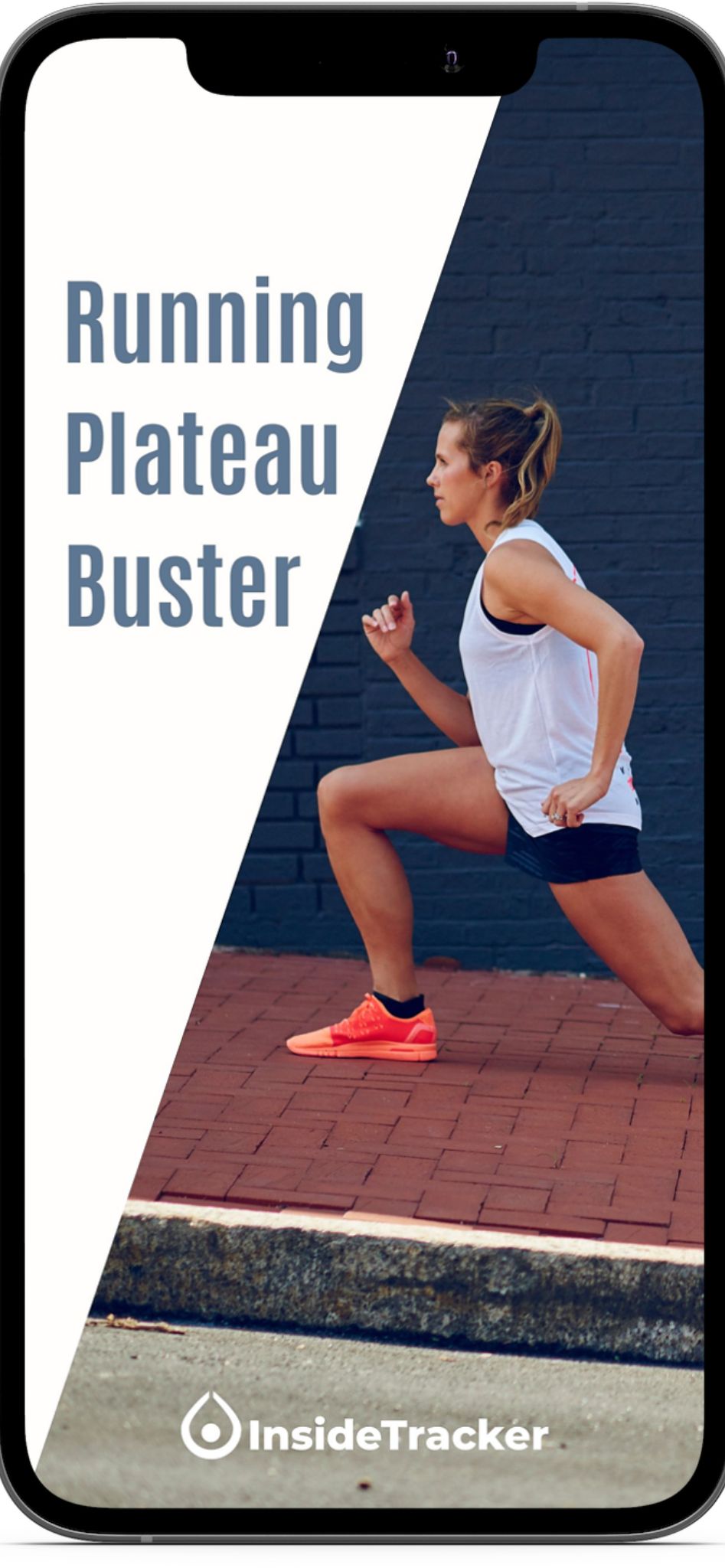The Boston Marathon Qualifying times bring a lot of chatter every year as we wonder if the standards will change again. A 2025 announcement, took an unexpected turn to find out that the actual times had not changed, but the rules about which races qualify did.
Qualifying races much be a full distance marathon (26.2 miles/42.195 kilometers) run by at least three participants. The course must be certified by USATF, World Athletics, AIMS, or a foreign equivalent governing body.
The changes, starting in 2027, deal with elevation drop.
Downhill BQ Qualifications
Since 2022, the Boston Athletic Association has worked with data scientists to determine whether or not athletes qualifying on courses with at least a 1,500-foot elevation drop have a measurable advantage over those who qualify at events that have a net elevation drop of less than 1,500 feet.
Their findings were that yes, they do, and they plan to address the discrepancy beginning in 2027. Any runner that qualifies on a course with a net-downhill over 1,500 feet will incur a time adjustment, known as an ‘index,’ to correct the advantage.
The changes will impact runners at roughly 24 marathons and around 3600 runners. At around 12% of the total Boston field (more when you take out the number of bibs given to media, charity, etc), this is a substantial change.
Have a downhill race this year? Get it in before September 15, 2025 and the rules don’t yet apply.
1. Over 6,000 Feet Downhill
While previously there were minimal stipulations, now courses that have an elevation drop greater than 6,000 feet (1,828.6 meters) between the start and finish will be not be acceptable for qualifying purposes.
Interesting to note that this accounts for about 1500 entrants in this year, which is about 5% of the total field, according to FindMyMarathon.com.
What does this mean for the future of popular races like Revel Mt Charleston and Revel Big Bear??? Will they see a large drop in registrations without the potential of a BQ?
Jack Fleming, President and Chief Executive Officer of the B.A.A., issued a statement on the changes.
“As the sport of marathoning has increased in popularity and the demand for a place in the Boston Marathon has reached record levels, the B.A.A. has continued to analyze race results from events across the world. The new downhill course adjustments are the next step in our evolving Boston Marathon registration process. We wanted to give athletes and events ample time to prepare in advance of the 2027 Boston Marathon registration period. We know athletes plan their qualifying marathons well in advance.”
2. Time Adjustments
Courses with a net-downhill between 1,500 and 2,999 feet will incur a 5-minute time adjustment, while courses with a net-downhill between 3,000 and 5,999 feet will incur a ten-minute adjustment.
In other words, if you run a 3:30 at the St George Marathon as a BQ for your age group (you needed 3:35), then you will be allowed to apply for 2027 Boston Marathon. However, upon receiving your time a 5 minute adjustment will be added moving your time up to 3:35.
If the same person ran a 3:35 on a course with 5 minute adjustment, then it would be considered a 3:40 and they will NOT be allowed to apply for Boston.
As we know every year people are missing out on being accepted from their Boston application by minutes, so that adjustment could indeed mean you no longer make the cut. In the last few years if the BQ time for your age was 3:30, you likely need to run a 3:25 or faster to get a spot.
All that to say, you will have earned a Boston Qualifying time, but it may not get in you in to the race.
How Do Runners Feel About the Change?
Since the news came out, runners have had mixed reactions.
Some, like Run_Rhandi_Run, think it’s only fair.
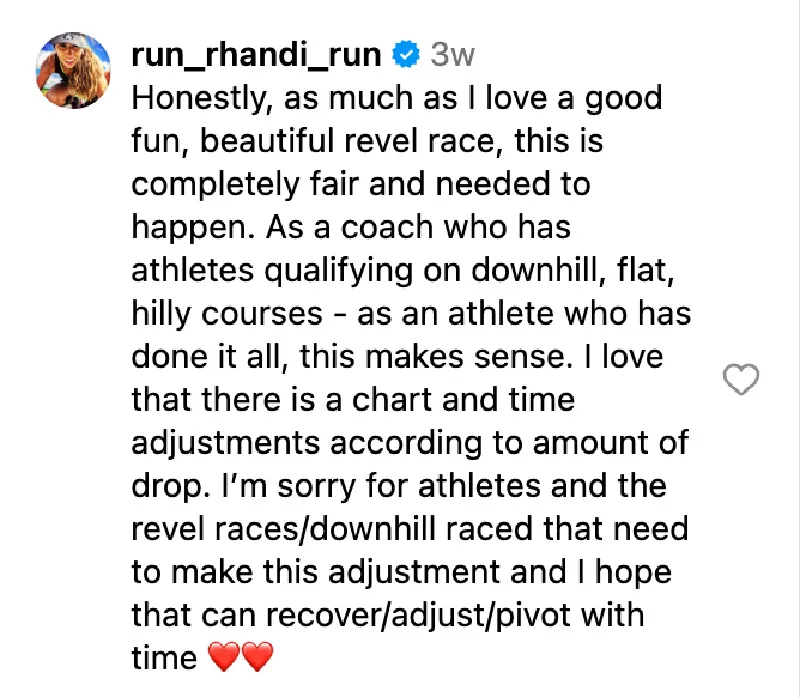
Athlisa agrees, and says it should have been done awhile ago.
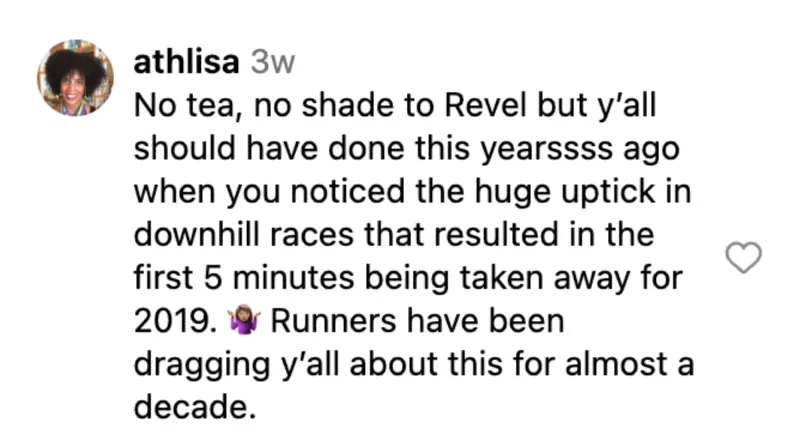
Plenty of people think they should have cracked down on other types of entrants instead (lots of agreement on comments like this one!).
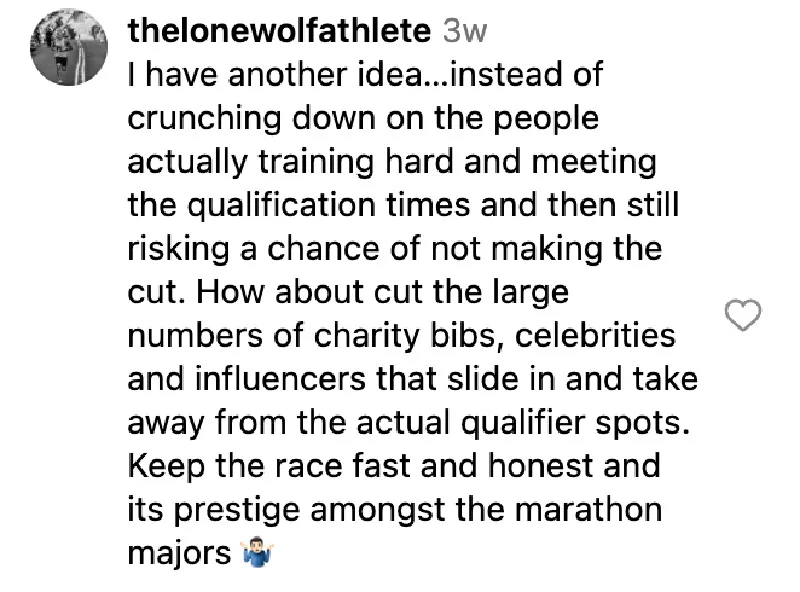
And katestring thinks they should have given runners more time to adjust.
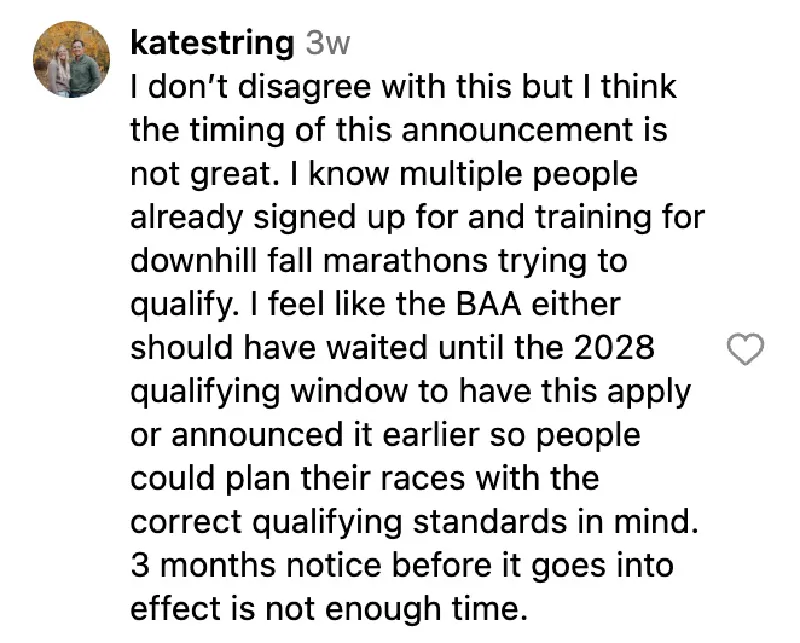
Boston Qualifying Downhill Marathons
You’re in luck, though, because there are still several downhill races that will allow you to qualify for Boston without any kind of time penalty.
This isn’t to say avoid the other bigger downhill races, they could net you a much faster time making the adjustment worth it. But if you want to know your time is your time, then these are the options to consider.
#1. Mountains 2 Beach (April)
Where: Ojai, California to downtown Ventura, California
Net Elevation Drop: 700 feet

You’ll start in downtown Ojai and enjoy beachfront scenery the entire 26.2 miles from the mountains down to the beach. The first six miles loops through Ojai, then runners trek downhill through back country roads before coming onto Ventura Ave. The scenery includes mountain peaks and the Ventura River Basin.
The finish line looms on the famous Ventura Beach, and beyond that, a festival to celebrate your finish.
Racer Abby says the course was tough but as far as qualifying for Boston, it worked for many!
This run starts in Ojai and has beautiful views of the mountains and countryside. There are gradual intense inclined the first 8-9 miles in Ojai area then most of the course is downhill after that.
I burned myself out with too fast a pace and paid for it (as many runners were struggling towards the end) but the ocean view and breeze to end the race was great!
This is not a very spectator-friendly course with lots of time on bike paths away from main streets.. be prepared to run more alone than with a group if you don’t stick with a pace.
Also, pretty sure this year they messed up the length of the race so that we all ran an extra .5 mile!
Many people Boston qualified!
#2. Mesa Marathon (February)
Where: Mesa, Arizona
Net Elevation Drop: 1000 feet
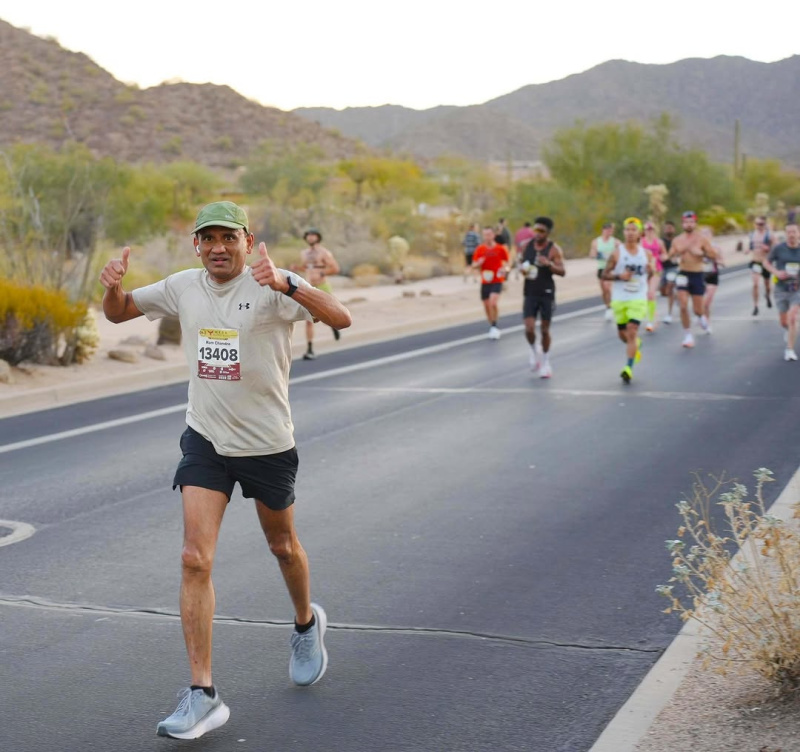
The weather is cool (at least in the morning), the course is mostly flat and fast, and the elevation drop is low enough that runners still qualify for Boston in 2027.
The race begins below the “Phoenix” sign on Usery Mountain and finishes at Riverview Park in Mesa, and in between is gorgeous, cactus-filled desert and views of the Phoenix Valley.
Racer Al says he wishes the scenery could have lasted, but was impressed with how the race was run overall:
This was my 18th marathon and this was one of the most organized races i have seen. In addition, the largest and best expo I have experienced.
Loved the start of the race up in the mountains and wish it would have lasted more than the first 4 miles. The later part of the race got a little boring as you are mostly running the streets of Mesa.
Overall great experience.
#3. Marquette Marathon (August)
Where: Marquette County, Michigan’s Upper Peninsula
Net Elevation Drop: 1037 feet
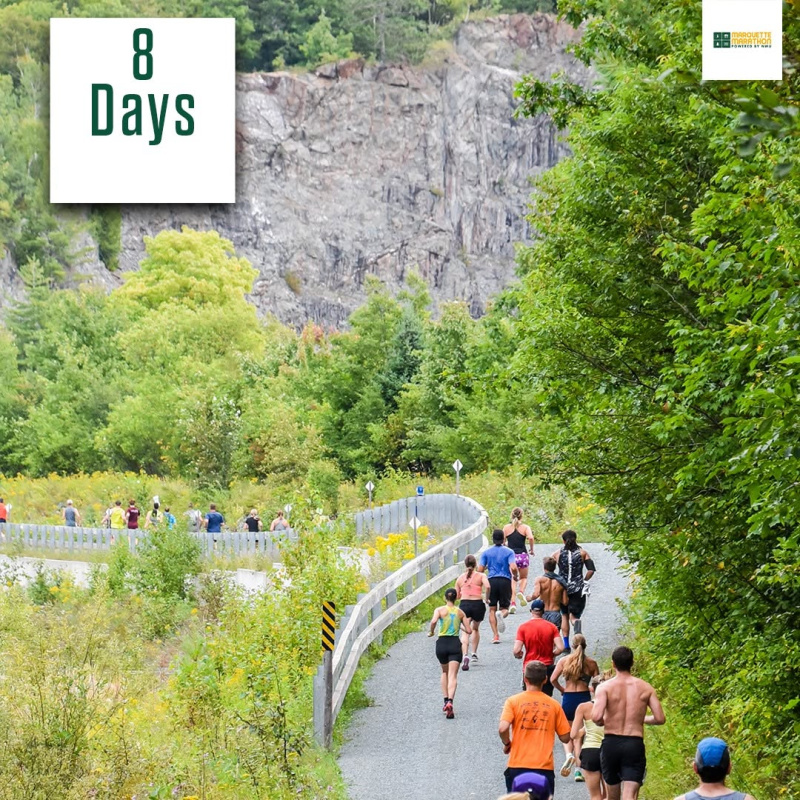
This is a beautiful area that contains an old mining town and scenic trail, but that finishes on a paved straightaway that’s flat and fast.
The course starts in Ishpeming, a small iron mining town that’s name means heaven in native Ojibwa. Runners then follow the Iron Ore Heritage Trail to the Superior Dome in Marquette.
First timer rebeccaruns360 from Race Raves absolutely loved it:
Surrounded by Lake Superior, Marquette is a beautiful, breezy city with expansive paved and gravel trails that you get to enjoy with this race.
The marathoners are shuttled to Ishpeming, MI to watch the sun rise of a small Midwest town.
Then it’s a quick jaunt through town to get onto the main trail.
Beautiful views, long downhill stretches, and frequent aid stations, this race was perfect for a first timer like me!
#4. Jack & Jill’s Downhill Marathon (July)
Where: North Bend, Washington
Net Elevation Drop: 800 feet
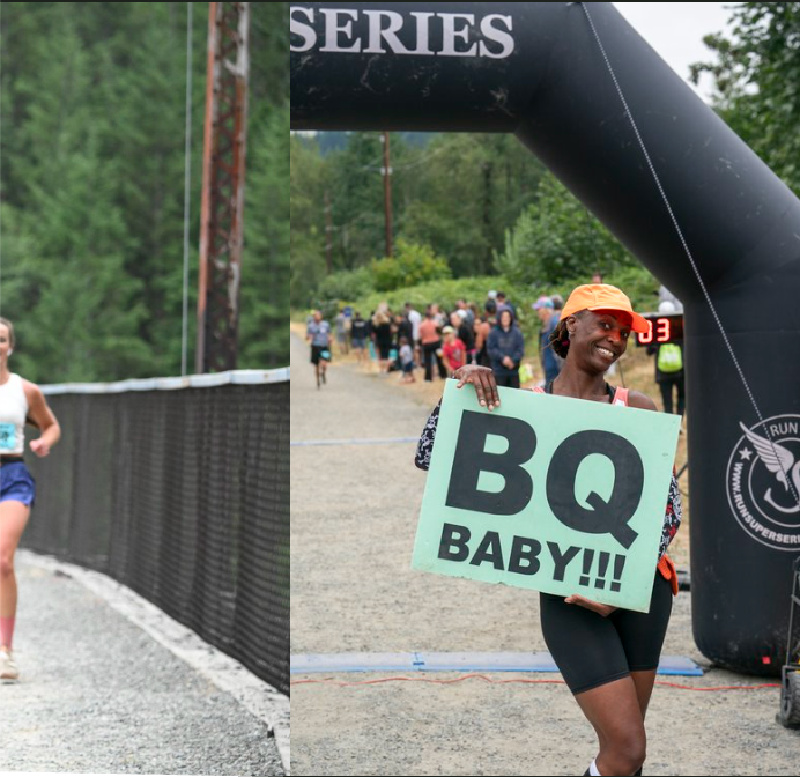
It doesn’t get prettier than the scenery in the Pacific Northwest, and this point-to-point race takes runners along the Lehigh Gorge. The course is soft and the downhill grade is gentle, which makes for a great place to try for that Boston qualifying time.
You’ll want to make sure you have a headlamp or flashlight for the start, which takes place in the Snoqualmie Tunnel. The rest of the course follows the John Wayne Trail, which is beautiful and an even dirt and gravel road.
Runner ihaveabshere was pleasantly surprised with her time:
The tunnel was very cool and the course was beautiful. The gradual decline gave me one of my best times even though my training was lacking.
The expo and post race activities were lackluster, but everyone was super friendly.
#5. Ogden Marathon (May)
Where: Ogden, Utah
Net Elevation Drop: 1100 feet
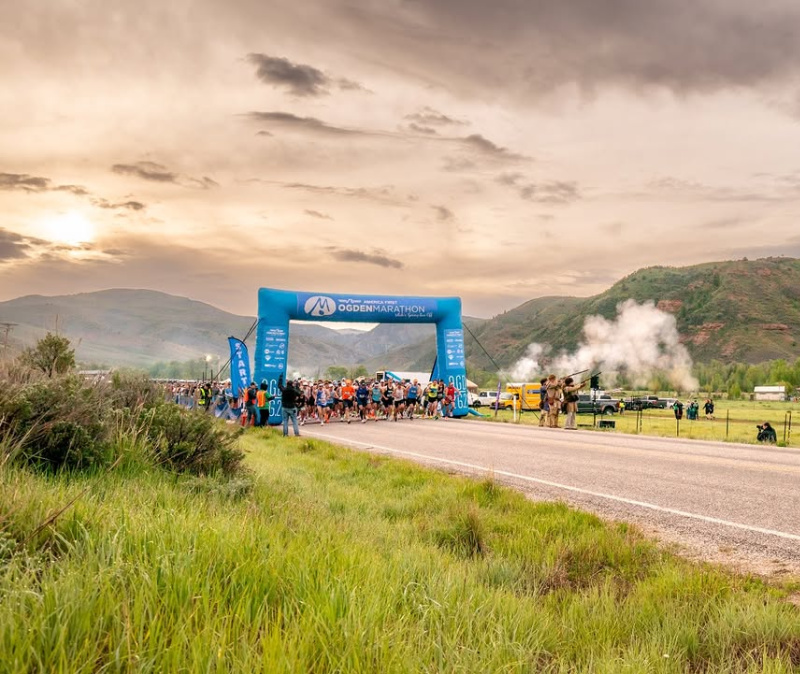
This beautiful run begins at 5400 feet of elevation , with open roads, rushing rivers, and green fields as far as the eye can see.
Past the halfway point, runners circle Pineview Reservoir before dipping down into Ogden Canyon and its powerful river.
The course ends in downtown Ogden at an elevation of 4309 feet.
Repeat runner Patrick says this one is hard to beat:
This was my first year running the marathon although I’ve ran the half twice before. I compare all my races to this course, and none have topped Ogden.
The organization is fantastic and the views are amazing! I can’t recommend this race enough!
This race has my heart.
#6. Salt Lake City Marathon (August)
Where: Salt Lake City, Utah
Net Elevation Drop: 700 feet
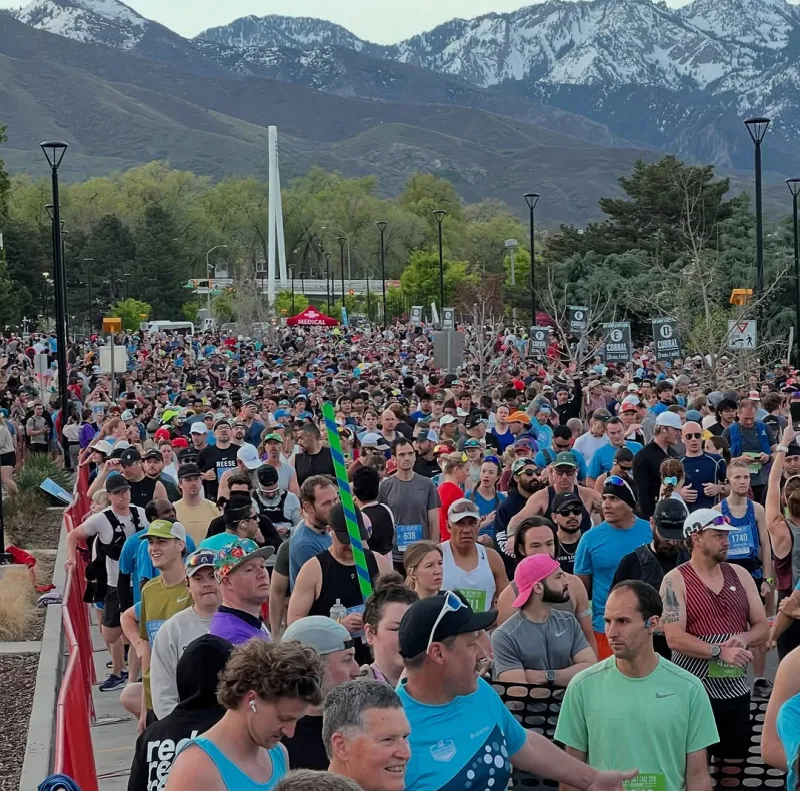
Though this course does steadily drop those 700 feet throughout, it’s gradual and only contains a few rolling hills. It’s got a city feel with a mountain backdrop, so the roads are paved and easy to navigate.
Completing this course is an accomplishment and will make you feel like you’ve seen many of the city’s highlights in the process.
Participant MattyIce says the course was more challenging than he expected:
I think this race could have been so much harder, but a thoughtfully routed course kept it very fair. I had no idea how hilly SLC was.
Got lucky with great weather and a fairly steep downhill start with ~7 min miles, then hung on for ~8 min average the rest of the race and kept my <8:00 overall average.
For a flatlander sea level dweller I am proud of my time.
I recommend this race for Utah.
These new qualification requirements are definitely something to keep in mind if you’d like to try qualifying for Boston in the next couple of years.
That said, a majority of runners feel the updated rules are fair, and there are still plenty of options out there for runners who enjoy all sorts of courses.
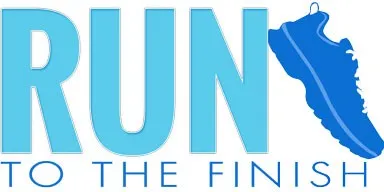


 True Grit: What to Do When Your Body Says Go But Your Mind Says No
True Grit: What to Do When Your Body Says Go But Your Mind Says No
